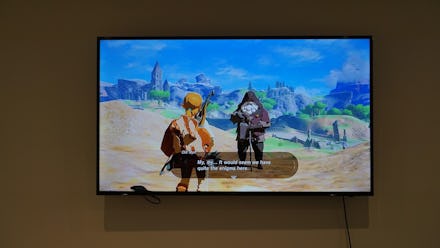'Zelda: Breath of the Wild' Timeline Theories: Fans can't place it, but does it matter?

In The Legend of Zelda: Breath of the Wild, between the Master Sword, the Hylian Shield, the inclusion of Twilight Princess' Wolf Link and a number of amiibo-specific outfits that are nods to old games, there's no shortage of allusions to previous games in the series. And yet, fans are confused about where exactly on the Zelda timeline the new game fits in.
'The Legend of Zelda' has always been about the journey and not the destination.
Ultimately, I'm not certain it matters where the Breath of the Wild takes place in the timeline. Legend of Zelda has always been about the journey and not the destination.
Zelda: Breath of the Wild timeline placement: Why can't fans place BotW?
Whether you agree or disagree with the official Zelda timeline that was revealed in Hyrule Historia back in 2011, longtime series designer Eiji Aonuma was a supervising editor on it — so good luck trying to dispute its canonicity.
Regarding Breath of the Wild's place in that timeline, Kotaku's Gita Jackson puts forth a pretty convincing argument that it's set in the Wind Waker timeline due to the game's inclusion of the Korok and Rito peoples. She also acknowledges that the placement of the Master Sword in Breath of the Wild is very similar to its placement in A Link to the Past, the original Legend of Zelda and Legend of Link, which would place it in a different timeline than Wind Waker, where the Master Sword is embedded in Ganondorf's head at the game's climax.
It's safe to say that Breath of the Wild's place in the Zelda canon is... muddled. There are references, both canon and non-canon, to many other entries in multiple timelines of the series, making it hard for fans to hammer out exactly when it takes place. Personally I'm most persuaded by Jackson's argument that it's post-Wind Waker, but I also don't put much stock in the overall timeline of Zelda.
Zelda: Breath of the Wild timeline theories: Why it doesn't matter
So does Breath of the Wild's place in the timeline really matter? Although I might catch hell for this, I'd argue that it doesn't. Really, the true timeline of Zelda comes from fans' collective investment in it, the references we're excited to see and the variations that surprise us.
If Breath of the Wild was your first Zelda game, you'd probably be indifferent to the inclusion of the Rito and Koroks because you wouldn't have a frame of reference for their prior inclusion in the series. But someone who played and loved Wind Waker would have a different experience with them, and would probably be excited to see this nod to an older game showing up in the newest one.
I acknowledge the desire to want to make sense of a game with a history and mythos as sprawling as Legend of Zelda's, even if it's never held much interest for me. But I believe that getting too hung up on how all the games fit together distracts you from what these references and nods to old games are meant to do. They're meant to let you trace your personal history with the series, forging your own personal journey through the various legends and incarnations of Hyrule.
Zelda: Breath of the Wild timeline placement: Time is a flat circle
The repeated inclusions of the Zora, or Gorons, or the Great Deku Tree, or even the Sheikah Tribe throughout the Zelda games all help reinforce the theme that you're experiencing variations on the same legend. Although you're probably pretty certain when you play a Zelda game that Link will collect ancient artifacts from about four to eight places of power collectively called "dungeons" and that you'll finish the game by fighting Ganon — or some other stand-in for an ancient evil — it feels different because you're noticing these small variations and new mechanics each time, compounding them on top of this story and setting you've loved for so long.
To look at this argument another way, at the end of Skyward Sword — which occupies the earliest spot in the current timeline — the pure incarnation of evil, Demise, curses both Link and Zelda to be inextricably linked to an incarnation of him in every age, and doomed to fight him each time he arises. It's sort of a downer, but it's also a pretty obvious metaphor for the series as a whole: the inexhaustible strength of evil being beaten back by someone strong and courageous enough to do so.
It's not about whether Link's silver arrow will strike true, or whether he'll find a break in Ganondorf's guard with his Master Sword — that's a foregone conclusion. Instead, it's about everything that leads up to that point, adding to the legends we've already been a part of and getting us excited about the legends we've yet to forge.
To me, that's the true beauty of these games. It's why I'll continue to come back to them and get excited about them, even after I swear I've hung up my Master Sword for good.
More Zelda: Breath of the Wild tips, tricks and guides
Find out all there is to know about Zelda: Breath of the Wild, including what to expect from the Wii U version, how to preserve your items, how to beat bosses like the Stone Talus, Lynel, the Guardians and the Hinox, the best recipes for Link, how to take on the game's shrines and our coverage of the game's outfits, like the Climbing Set, the two sets of heat resistance armor you can find and how to dress Link in the classic green tunic. You'll also want to find out where all the great fairies in the game, all available stables, how to use amiibo with your version of Zelda and how to increase your health, stamina and weapon slots.